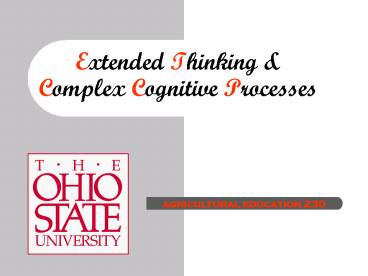Extended Thinking - PowerPoint PPT Presentation
1 / 23
Title:
Extended Thinking
Description:
... Thinking & Complex Cognitive Processes. agricultural education ... Use analogies in teaching content. Let's Move from the Teaching Side to the Learning Side... – PowerPoint PPT presentation
Number of Views:34
Avg rating:3.0/5.0
Title: Extended Thinking
1
Extended Thinking Complex Cognitive Processes
agricultural education 230
2
Objectives
- Comprehend the importance of thinking and
understanding. - Understand concepts and how to teach them
- Become familiar with learning strategies and
study skills. - Describe how a teacher teaches for transfer.
3
The Importance of thinking and understanding
- 224
- 4 x 10 40
- pr2
4
- Understanding involves appropriately
transforming and using knowledge, skills, and
ideas - (Woolfolk, 2004)
5
- Most of what we know about the world involves
concepts and relationships between these
concepts. - so what is a concept?
6
Concept
- Concept a category used to group similar
events, ideas, objects or people - Concepts are abstracts
- Do not exist in real world
- Only examples of concepts exist
7
Definitions to help understand concepts
- Defining attributes distinctive features shared
by members of a category - Concepts share a set of defining attributes
- Example- books
- Group example
- Prototypes Best representative of a category
- Example- birds
- Members of the category may be very similar to
the prototype or very different - Some objects and ideas are better examples of
concepts than others - Exemplar a specific example of a given category
that is used to classify an item - memories of things that we use to compare with an
item in question to see if that item belongs in
the same category as our exemplar
8
Concept Attainment
- A way of helping students construct an
understanding of specific concepts and practice
thinking skills such as hypothesis testing.
9
4 Components of Concept Attainment
- Examples and Non-examples
- Relevant and Irrelevant Attributes
- Name of the Concept
- Definition
10
Phases in Concept Attainment Teaching
- Present Data and Identify Concept
- Test for Understanding
- Analyze Thinking Strategies
11
Teaching concepts
- Identify existing knowledge to use as a starting
point to build upon. - Use advance organizers to frame lesson to work
within. - Use analogies in teaching content
- Lets Move from the Teaching Side to the Learning
Side...
12
Learning Strategies and Study Skills
- Learning Strategies and Tactics
- Visual Tools for Organization
- Reading Strategies
- Applying Learning Strategies
13
Advance Organizers prepare Learners to use
Strategies and Tactics
- Learning StrategiesIdeas for accomplishing
learning goals - An overall plan of attack - Learning TacticsSpecific techniques that make up
the plan - Decide what is important.
- Students often focus on seductive details or
concrete examples - Stories, jokes, etc.
14
When you read, use Summaries
- Students should
- Find or write a topic sentence for each paragraph
or selection - Identify big ideas that cover several specific
points - Find some supporting information for each big
idea - Delete any redundant information or unnecessary
details
15
Tips 4 Underlining and Highlighting
- Better to be selective as to what to highlight.
- I.e. One sentence per paragraph
- Transform information into your own words.
- Draw Diagrams to illustrate relationships.
- Look for organizational patterns in the material.
16
Tips 4 Taking Notes
- Record key ideas by translating, connecting,
elaborating, and organizing information into your
own words. - More is better as long as you capture key ideas,
concepts, and relationships. - Use your notes to create personal codes so that
you remember those key concepts.
17
Visual Tools for Organizing
- Graphic Organizers
- Mapping noting casual connections,
comparison/contrast connections, and examples. - This improves recollection
- Venn Diagrams tree diagrams showing how ideas
branch off of each other. - Timelines organizing information in sequence
18
Reading Strategies
- READS
- R review headings and subheadings
- E examine bold faced words
- A ask, What do I expect to learn?
- D do it read
- S summarize in your own words
19
more Reading Strategies
- PQ4R
- P preview major topics
- Q question - for each major section, create a
question - 4 Rs
- Read
- Reflect
- Recite
- Review
20
even more Reading Strategies
- CAPS
- C characters Who are the characters?
- A aim What is the aim of the story?
- P problem What problem happens?
- S solved How is the problem solved?
21
and yet another Reading Strategy
- KWL
- K know What do I already know about this
subject? - W want What do I want to know?
- L learn What have I learned?
22
Applying Learning Strategies
- Learning tasks must be appropriate.
- Students must
- care
- believe that the effort required to apply the
strategies are reasonable, given the returns. - believe they are capable of using the strategies.
23
Teaching for Transfer
- Transfer
- Influence of previously learned material on new
material - I.e. Math equations used in physics
- Overlearning
- Practicing a skill past the point of mastery
- I.e. Being able to recall something whenever it
is needed. - Brushing teeth, Tying your shoe, Multiplication,
Adding/Subtracting - Low-Road Transfer
- Spontaneous and automatic transfer of highly
practiced skills. - I.e. Practice with skills make them automatic
to any situation - High-Road Transfer
- Application of abstract knowledge learned in one
situation to a different situation. - I.e. Learning something in one class and then
reusing it in another class.































